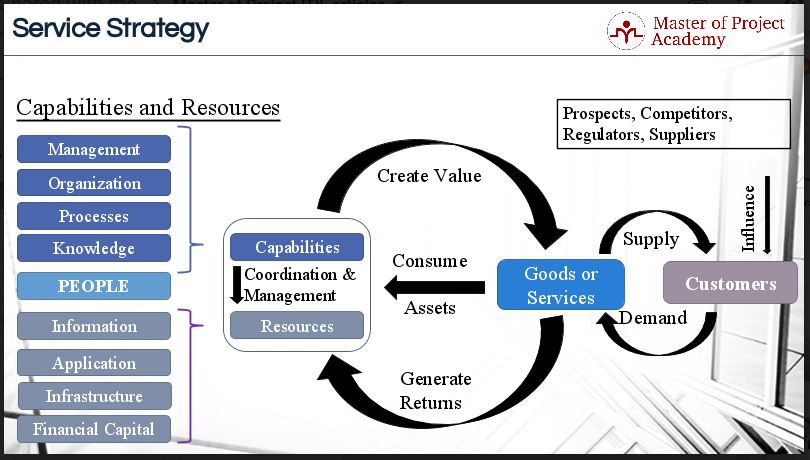IT organizations’ main goal is to provide services to their customers. These services must be valuable to the customer if it is to be successful. In order to be valuable, it must be useful and it must be consistently available according to the requirements of the customer. IT service providers cannot provide a value-adding service without effectively managing its strategic capabilities and resources. Failure to manage strategic capabilities and resources will prevent an organization from creating value for its customer. This can be detrimental to the organization’s ability to generate sales and revenue. But what are the strategic capabilities and resources available to an IT organization according to IT Service Management Certification Training? Let’s have a look at Strategic Capabilities and Resources in an IT business.
Strategic Capabilities and Resources in an IT Business
First, we must review the ITIL definitions of capabilities, resources, and assets within an IT organizational structure. Understanding the differences between these three components is key to understanding how they can be used to create value for your customer.
Strategic resources
ITIL defines a resource as a generic term that includes IT infrastructure, people, money or anything else, that might help to deliver an IT Service. The difference between strategic resources and strategic capabilities is that you can buy or acquire resources with a determined budget. Therefore, resources are tangible assets of an organization.
In an IT organization, the following are strategic resources:
- Financial capital
- Infrastructure
- Applications
- Information

Strategic capabilities
Strategic capabilities are the abilities of an organization, person, process, application, configuration item (CI), or IT service to carry out an activity. Strategic capabilities are the intangible assets of an organization. This means that you cannot purchase a capability with your financial resources. The strategic capabilities of an organization are:
- Knowledge
- Processes
- Organization
- Management
- People
Let’s say that your company hired a very skillful manager from another company. If there is not a mature management and organization structure in the company, this skillful manager himself cannot change the company. Therefore, although there can be sufficient resources in a company, if there are not sufficient strategic capabilities to use these resources, the output will not be as expected. Resources must be consumed and used effectively with the help of adequate strategic capabilities in order to provide good results. Although a company might have sufficient resources, if the required strategic capabilities to manage these resources are not available, successful outputs won’t be produced.
Enhance your team’s effectiveness, deliver complex projects faster, and boost your career trajectory by earning PMI-ACP certification.

Service asset
A Service Asset is any capability or resource of a Service Provider. If we look to the word “asset” itself, it is the designation of any resource or capability. Assets of a service provider cover anything that could contribute to the delivery of a service. If you think from this perspective, all strategic capabilities or resources of an organization contribute to the delivery of the services to the customers. Therefore, all of the strategic capabilities and resources are assets of an organization.
During the Service Strategy stage of the ITIL lifecycle for services, the organization’s capabilities, resources, and assets must be taken into account when generating an IT strategy. Without sufficient strategic capabilities, resources, and assets, a new service cannot be successfully launched and operated.
How strategic capabilities are affected by delivery of services
Therefore, the capabilities of an organization coordinate, control, and deploy resources of an organization. An organization creates goods and services to create value for its customers with the help of its strategic capabilities and resources. These goods and services consume the assets of the organization. An asset is defined by ITIL online courses as any capability or resource of an organization. A company provides services and goods to earn money from its customers. Strategic capabilities and resources facilitate the organization ability to provide goods and services that generate returns in the end.
The effect of supply and demand on Strategic Capabilities and Resources in an IT business
In addition, there is a supply and demand balance between customers and an organization. If the provided services and goods of an organization create a high demand in the market, then the organization needs to adapt itself to supply the required demand from the market.
Let’s imagine that a mobile operator launched a new service for its football fans which sends instant match scores via SMS. If there is a higher demand for this service than expected, the telecom operator must meet the required demand from its customers.
Market conditions, harsh competition, and time-to-market are the biggest concerns of today’s organizations, especially for technology companies. To adapt to this fast-changing environment, most of the organizations adopt Agile Project Management methodologies. This ensures the organizations to produce valuable outputs faster. Scrum Framework is the most popular Agile Methodology. Enroll in our Scrum Master course and get the Professional Scrum Master (PSM) Certification!
Environmental factors affecting strategic capabilities and resources
The last factor that should be placed in this picture is the enterprise environmental factors. Prospects, competitors, regulators, and suppliers affect the goods and services provided by the organizations in a market. If there is a high competition in the market, then the organization should outplay its competitors with new goods and services or improved goods and services in order to survive.
Similarly, if there is a regulating authority that dictates some rules or code of conducts in the country or globally, such as security requirements, health requirements etc., these will affect the goods and services that will be provided by the organizations to the market.
The strategic capabilities and resources available to the company dictate which services can be successfully deployed and operated. The successful operation, in this case, means that the service provides value to the customer and thereby customer satisfaction. Customer satisfaction results in repeat sales and potentially draws new customers. From a strategic business perspective, the value-adding factors of the new service can be built into the marketing plan to draw new customers. With each new service launched, the IT service manager must be prepared to ensure that there are sufficient capabilities and resources available to effectively operate the new service along with existing services.
Review by: Matthew Craig

